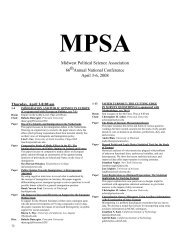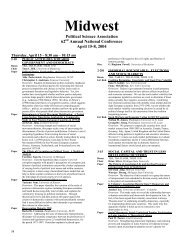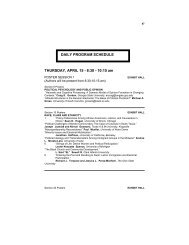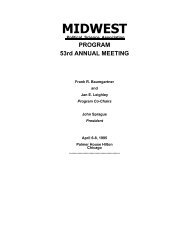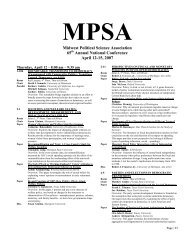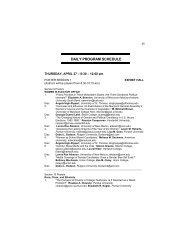PaperDisc.never seems to provide us with his own systematic treatment orconcise definition.The Liberated Beast: An Evolutionary Justification of<strong>Political</strong> LibertyLauren K. Hall, Northern Illinois UniversityOverview: TBAJames Chalmers, Wayne State UniversityJames H. Read, College of St. Benedict28-6 PRODUCING PLURALISMRoomChairPaperPaperPaperPaperDisc.TBA, Sat 8:30 amRoudy W. Hildreth, Southern Illinois University, CarbondaleConstitutional Democracy as Machiavellian PluralismEric S. Petrie, Michigan State UniversityOverview: Constitutional democracy, with its pluralist politics--its multiple competing political actors--will be analyzed as inlight of Machiavelli's teaching about republics. Dahl, Shklar,Rorty and Harvey Mansfield will be the theorists examined.Hume, Liberal Personality and Contemporary DemocracyTom J. Hoffman, University of Illinois, Urbana-ChampaignOverview: This paper situates David Hume's conception of agood person within the broader intellectual tradition of liberaltheory. The civic adequacy of his conception of the person isdefend in light of the demands of large-scale representativedemocracy.Liberal Norms and Social Movement Alliances: Jaurès onthe Dreyfus AffairGeoffrey Kurtz, Rutgers UniversityOverview: Social movements represent distinct interests and,often, distinct cultural frameworks. This paper asks: How cansocial movements ally with one another?Hume's Historical LiberalismPhilip Bretton, Michigan State UniversityOverview: Hume makes a case for liberalism without havingrecourse to metaphysical arguments. In his History of Englandhe reaches liberal conclusions by way of an experimental orhistorical method.Louis Hunt, Michigan State UniversityPeter Breiner, SUNY, Albany28-11 LIBERTY AND EQUALITY INTOCQUEVILLERoomChairPaperPaperPaperPaperDisc.TBA, Sat 8:30 amWill R. Jordan, Mercer UniversityTocqueville, Pascal and the Psychology of FreedomMichael L. McLendon, California State University, LosAngelesOverview: Tocqueville's portrait of the American psyche can bebroken down into two parts, Cartesian rationality and Pascaliananxiety. The tensions created by the interplay of the twomotivate Americans to maintain political freedom.Tocqueville on Personal and <strong>Political</strong> LibertyLouie J. Hebert, Saint Ambrose UniversityOverview: An exploration of the ways free political institutionswork for or against the liberty of citizens, exploring the tensionTocqueville perceives between freedom from being ruled andthe liberty available to citizens through self-government.Tocqueville, Weber, and Democracy: The Condition ofEquality and the Possibility of Charisma in AmericaLee Trepanier, Saginaw Valley State UniversityOverview: This paper will examine the specific problems thatmodern democracy posed to both Tocqueville and Weber andhow each thinker surmounted these difficulties to provide ajustification for mass democracy.Tocqueville and French LibertyAnnelien Dijn, Columbia UniversityOverview: This paper aims to reconsider Tocqueville's positionin the political culture of his time. It argues that Tocquevillemust be seen as an exponent of a typically French way ofthinking about liberty, rather than as an isolated thinker.Fiona Miller, Colgate University29-1 RETHINKING REPRESENTATIONRoomChairPaperPaperPaperPaperDisc.TBA, Sat 8:30 amNadia Urbinati, Columbia UniversityRe-Thinking Re-PresentationLisa Disch, University of MinnesotaOverview: Agents such as citizen representatives and opinionpolls confound Pitkin's regulative ideal of responsiveness. If"the represented" is not "somehow logically prior" to itsrepresentation, must mass democracy shade into "fascist"manipulation?Citizen RepresentativesMark E. Warren, University of British ColumbiaOverview: Citizen representative bodies are increasinglycommon in practice but almost untheorized within democratictheory.Citizen Representation and the American JuryEthan J. Leib, University of California, San FranciscoDavid L. Ponet, Columbia UniversityOverview: This paper explores a framework for assessingAmerican citizen representation by looking at the implicittheory of citizen representation that can be isolated by analyzingthe American jury system.Citizen Panels and the Elements of DemocraticRepresentationMark B. Brown, California State University, SacramentoOverview: This paper explores the implications of certain typesof citizen advisory panels for theories of representativedemocracy.Nadia Urbinati, Columbia University30-11 FORMAL THEORIES OF FEDERALISM IIRoomChairPaperPaperPaperDisc.TBA, Sat 8:30 amHaldun Evrenk, Suffolk UniversityFederal Theory and the Problem of Credible CommitmentMikhail Filippov, Binghamton UniversityOverview: In this paper we formalize the arguments of anumber of theorists of federalism, to show that they have acommon conception of the difficulty in establishing/maintainingthe federal constitutional form. Modeling the agents who takepart in the federaA Formal Model of Learning and Policy DiffusionMichael M. Ting, Columbia UniversityCraig Volden, The Ohio State UniversityDaniel P. Carpenter, Harvard UniversityOverview: We present a model of learning and policy choiceacross governments and over time. A key feature of our modelis the presence of informational externalities that affect eachpolicy-maker's choices.Fiscal Federalism, Public Goods, and Redistributive PoliticsBrian Roberson, Miami UniversityOverview: This paper examines centralized and decentralizedelectoral competition in a model of redistributive politics withlocal public goods. In equilibrium, decentralization is moreefficient due, not to spillovers, but the targetability of resources.Haldun Evrenk, Suffolk University30-19 FORMAL THEORIES OF PRIVATEPOLITICSRoomChairPaperPaperTBA, Sat 8:30 amKrishna Ladha, University of MississippiStrategic ActivismDaniel Diermeier, Northwestern UniversityDavid P. Baron, Stanford UniversityOverview: TBAWhen Do Mafias Become Governments?Catherine Hafer, New York UniversityEthan Bueno de Mesquita, Washington University, St.LouisOverview: Two mafias prey on productive firms in a repeatedgame.196
PaperDisc.Negative-Sum Games, Anonymity and InteractionDaniel Rubenson, University of MontrealRichard Walker, London School of EconomicsOverview: Social capital theory holds that the topology ofinterpersonal relationships---as distinct from anonymous,market-based transactions---can affect societal productivity,broadly defined.Skyler J. Cranmer, University of California, DavisKrishna Ladha, University of Mississippi31-6 THE STATE OF SURVEY METHODOLOGYRoomChairPaperPaperPaperPaperDisc.TBA, Sat 8:30 amJon A. Krosnick, Stanford UniversityThe Distinguishing Characteristics Of Frequenct SurveyParticipantsJon A. Krosnick, Stanford UniversityOverview: Using data from a national survey of 9,000respondents, we find that many personality and lifestyle factorspredict frequent participation in surveys, but each one onlyweakly. This is reassuring about political survey samplecomposition.vb: Analyze Vote BehaviorJoan Serra, University of ChicagoOverview: This paper introduces vb, a package to analyze votebehavior. This package, designed for the R computingenvironment, computes the impact of the different factors thataffect the choice of voters from among two or more parties andabstention.Alternatives to Conventional Practices for Ordinal,Categorical Response VariablesBradford Jones, University of ArizonaChad Westerland, University of ArizonaOverview: This paper notes that conventional modelingstrategies for ordinal categorical response variables in socialsciences frequently belie properties and assumptions of standardcumulative link models like the proportional odds model.Dynamic Conditional Correlations in <strong>Political</strong> <strong>Science</strong>Matthew J. Lebo, Stony Brook UniversityJanet M. Box-Steffensmeier, The Ohio State UniversityOverview: DCC models estimate dynamic relationships overtime. We explain the method and show that the impact of ICScomponents vary considerably over time as predictors ofpresidential approval. An example using IR data is alsopresented.John W. Patty, Harvard University32-8 INTEREST GROUPS, MONEY, ANDELECTIONSRoomChairPaperPaperPaperTBA, Sat 8:30 amAmy M. McKay, Duke University/Loyola UniversityNon-Connected vs Ideological PACs: Candidate Choice andContribution TimingDorie Apollonio, University of California, San FranciscoRaymond J. La Raja, University of Massachusetts, AmherstOverview: Using a new method to distinguish business interestsfrom ideological groups, we find that although ideologicalgroups prefer outside candidates, they make late contributions.These findings have important implications for electoralcompetitiveness.Broadcast Industry PACs' Influence on CongressionalBehavior: A Quantitative Study of the Relationship BetweenCampaign Contributions and Roll Call VotesJason Barlow, Randolph Macon CollegeOverview: This study examines the relationship betweenmembers of Congress' voting behaviors on legislationconcerning broadcasting and broadcast industry political actioncommittees' (PAC) contributions to congressional campaigns.An Examination of Ethnic <strong>Political</strong> Action CommitteeStrategies, 1998-2004.David M. Paul, The Ohio State University, NewarkOverview: Using FEC data from 1998 to 2004, this projectanalyzes the contribution strategies used by ethnic politicalaction committees (PACs).PaperPaperDisc.Wither the Soft Money? The Effect of BCRA onContribution PatternsStacy B. Gordon, University of Nevada, RenoChristopher McGill, University of Nevada, RenoOverview: We compare soft money contributions to politicalparties prior to the passage of the BRCA to contributions givento 527s, post-BRCA.Voter's Information, Electoral Competition and the Powerof Interest Groups in the USTim C. Wegenast, University Pompeu FabraOverview: The paper analyzes the effect of electoralcompetition and voters' level of information on the influence ofinterest groups within the political arena of the United States.Allan J. Cigler, University of Kansas33-6 PRESIDENTIAL RESPONSIVENESS TONATURAL DISASTERSRoomChairPaperPaperDisc.TBA, Sat 8:30 amDaniel M. Cook, University of California, San FranciscoVulnerability and Responsiveness in U.S. Disaster PolicyR. Steven Daniels, California State University, BakersfieldOverview: Executive decision-making on disaster policyreflects comprehensive vulnerability management, politicalresponsiveness, political negotiation, and intergovernmentalconflict. This paper examines 2,400 presidential decisionsbetween 1953 and 2005.Hurricane Katrina as a Focusing Event: Public PolicyObservationsFrank T. Manheim, George Mason UniversityOverview: The results from Hurricane Katrina offer a windowinto an array of issues. These range from Executive Branchappointments, to social questions such as the linkage betweenNew Orleans' special character and poverty.Anna Marie Schuh, Roosevelt University34-10 POLICY MAKING IN CONGRESSRoomChairPaperPaperPaperDisc.TBA, Sat 8:30 amGeorge Serra, Bridgewater State CollegeThe Timing and Structuring of Abortion-Related Proposalsin the U.S. HouseScott Ainsworth, University of GeorgiaThad Hall, University of UtahOverview: We examine how abortion politics has evolved overtime within the U.S. Congress, evaluating sponsorship,entrepreneurial efforts, and committee turf concerns.Welfare Politics in CongressLawrence M. Mead, New York UniversityOverview: We code witnesses in Congressional hearings duringsix episodes of welfare reform between 1962 and 1996. Wefind that over time positions shift to become more conservative,but also that disputes become less ideological and morepractical.Deceived by Emotion?: House Members' Votes on the USAPatriot ActDaniel R. Bowles, Randolph Macon CollegeOverview: This paper reveals some of the key relationships thataffected member voting on the USA Patriot Act in the House ofRepresentatives in 2001 by examining general influences onmembers' voting behaviors.Joseph N. Patten, Monmouth University34-19 THE EFFECTS OF PARTY POLARIZATIONRoomChairPaperTBA, Sat 8:30 amJon R. Bond, Texas A&M UniversityThe Sources of Bipartisan Politics in ParliamentaryDemocraciesThomas Braeuninger, University of KonstanzMarc Debus, University of KonstanzOverview: We develop a saliency-based spatial model thatrelates electoral, institutional and policy sources to thelikelihood that a bill is sponsored by government and oppositionactors in parliamentary democracies.197
- Page 1 and 2:
MidwestPolitical Science Associatio
- Page 4 and 5:
9-4 STATE BUILDING AND BUREAUCRATIC
- Page 6 and 7:
14-1 GLOBALIZATION AND SECURITYRoom
- Page 8 and 9:
PaperPaperDisc.The Divide: African
- Page 10 and 11:
29-210 INFORMAL ROUNDTABLE: CULTURE
- Page 12 and 13:
PaperDisc.Defining Federalism: The
- Page 14 and 15:
PaperDisc.estimates connections amo
- Page 16 and 17:
3-26 THE DETERMINANTS OF ECONOMICGR
- Page 18 and 19:
PaperPaperPaperDisc.Bad Civil Socie
- Page 20 and 21:
PaperPaperDisc.Voting Patterns in t
- Page 22 and 23:
PaperDisc.'Going Local': Candidate
- Page 24 and 25:
PaperPaperDisc.90Reflections on Lit
- Page 26 and 27:
Presenter Out of Time: Examining th
- Page 28 and 29:
is: to what extent are intergovernm
- Page 30 and 31:
Presenter Economic Inequality, Its
- Page 32 and 33:
PaperPaperPaperPaperDisc.during the
- Page 34 and 35:
10-3 BACK TO EUROPE? THE EU AND"EUR
- Page 36 and 37:
PaperPaperPaperDisc.Interested Part
- Page 38 and 39:
PaperPaperthatDisc.Don't Know, Don'
- Page 40 and 41:
Disc.Suzanne Soule, Center for Civi
- Page 42 and 43:
epistemology which is attentive to
- Page 44 and 45:
37-3 CONSTITUTIONAL INTERPRETATIONA
- Page 46 and 47:
47-201 INFORMAL ROUNDTABLE: RELIGIO
- Page 48 and 49:
PaperPaperDisc.terms and reciprocal
- Page 50 and 51:
PaperPaperPaperDisc.116Education, E
- Page 52 and 53:
19-202 INFORMAL ROUNDTABLE: YOUNG A
- Page 54 and 55:
26-6 ASIAN AMERICAN POLITICSRoomCha
- Page 56 and 57:
PaperPaperPaperDisc.of how partisan
- Page 58 and 59:
PaperPaperDisc.124An Experimental S
- Page 60 and 61:
PaperPaperDisc.Policy Windows, Atte
- Page 62 and 63:
Friday, April 21 - 8:30 am - 10:15
- Page 64 and 65:
PaperPaperPaperDisc.The Determinant
- Page 66 and 67:
PaperPaperDisc.A Simple Game-Theore
- Page 68 and 69:
PaperDisc.partisans is causing chan
- Page 70 and 71:
28-201 INFORMAL ROUNDTABLE: DEWEY'S
- Page 72 and 73:
35-4 THE EFFECTS OF REDISTRICTING O
- Page 74 and 75:
Presenter Regulation, Enforcement a
- Page 76 and 77:
Friday, April 21 - 10: 30 am - 12:1
- Page 78 and 79:
PaperPaperDisc.144Regional Minority
- Page 80 and 81: PaperPaperDisc.Administration of Gl
- Page 82 and 83: PaperPaperPaperDisc.The Paradox Soc
- Page 84 and 85: Disc.("Policy Mood") since 1972 usi
- Page 86 and 87: Disc.likelihood of a filibuster is
- Page 88 and 89: 38-301 POSTER SESSION: COMPARATIVEI
- Page 90 and 91: 54-1 SOCIAL ACTIVISM AND CIVICENGAG
- Page 92 and 93: 3-203 INFORMAL ROUNDTABLE: THE LEGA
- Page 94 and 95: PaperPaperPaperPaperDisc.Toward Res
- Page 96 and 97: Presenter The Shanghai Cooperation
- Page 98 and 99: PaperPaperPaperDisc.poised to becom
- Page 100 and 101: PaperDisc.chapter in Foucault's int
- Page 102 and 103: PaperDisc.Campaign Ad Images as Sig
- Page 104 and 105: 43-6 INDEPENDENT SCRUTINY OF AGENCI
- Page 106 and 107: Friday, April 21 - 3:45 pm - 5:30 p
- Page 108 and 109: 6-2 PARTIES AND PARTY DISCIPLINERoo
- Page 110 and 111: PaperDisc.assesses the impact of co
- Page 112 and 113: 19-301 POSTER SESSION: VOTING BEHAV
- Page 114 and 115: 24-9 WHO LEADS: UNTANGLING THERELAT
- Page 116 and 117: PaperPaperPaperDisc.182Understandin
- Page 118 and 119: Paper The Rehnquist Court and the N
- Page 120 and 121: PaperDisc.Revenge of Socialist Supe
- Page 122 and 123: Saturday, April 22 - 8:30 am - 10:1
- Page 124 and 125: PaperDisc.South Korean Public Opini
- Page 126 and 127: PaperDisc.several other variables b
- Page 128 and 129: 22-15 PRESIDENTIAL APPROVAL (Co-spo
- Page 132 and 133: PaperPaperPaperDisc.Polarization an
- Page 134 and 135: PaperDisc.Networks of Local Governm
- Page 136 and 137: 47-203 INFORMAL ROUNDTABLE: RELIGIO
- Page 138 and 139: PaperPaperPaperPaperDisc.Between De
- Page 140 and 141: 11-9 NEW THEORIES AND THUS NEWDEBAT
- Page 142 and 143: PaperPaperPaperAre Political Market
- Page 144 and 145: 26-9 MINORITY REPRESENTATIONRoomCha
- Page 146 and 147: PaperDisc.Evolving Political Machin
- Page 148 and 149: PaperPaperPaperDisc.economic gains
- Page 150 and 151: PaperPaperPaperDisc.A Social Versus
- Page 152 and 153: Saturday, April 21 - 1:45 pm - 3:30
- Page 154 and 155: PaperPaperDisc.Riptides in Ontario:
- Page 156 and 157: PaperPaperPaperDisc."works," a stat
- Page 158 and 159: PaperPaperPaperPaperDisc.Preference
- Page 160 and 161: PaperPaperPaperDisc.226that encoura
- Page 162 and 163: 32-12 POLITICAL PARTIES IN ELECTION
- Page 164 and 165: PaperPaperDisc.Challenging Others o
- Page 166 and 167: 52-3 SOCIAL POLICIES: CHALLENGES AN
- Page 168 and 169: Saturday, April 22 - 3:45 pm - 5:30
- Page 170 and 171: PaperDisc.It's Not the Economy Stup
- Page 172 and 173: 15-10 DEMOCRACY, EQUALITY, AND PEAC
- Page 174 and 175: Presenter Polarization, Public Opin
- Page 176 and 177: PaperDisc.John S. Mill and Alexis d
- Page 178 and 179: PaperDisc.Lobbying by Transportatio
- Page 180 and 181:
42-202 INFORMAL ROUNDTABLE: DOMESTI
- Page 182 and 183:
Presenter Female Athletes Making He
- Page 184 and 185:
PaperPaperDisc.Micro-Level Determin
- Page 186 and 187:
PaperDisc.Governmental Structure, P
- Page 188 and 189:
PaperDisc.Social Class Identity and
- Page 190 and 191:
33-9 PRESIDENTIAL-CONGRESSIONALRELA
- Page 192 and 193:
PaperPaperDisc.Equal Employment Opp
- Page 194 and 195:
Sunday, April 23 - 10:30 am - 12:15
- Page 196 and 197:
PaperPaperPaperDisc.State Legitimac
- Page 198 and 199:
18-14 THE STUDY AND MEASUREMENT OFR
- Page 200 and 201:
28-14 ROUSSEAU RECONSIDEREDRoomChai
- Page 202 and 203:
PaperDisc.The Judicial Treatment of




